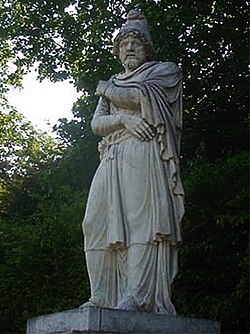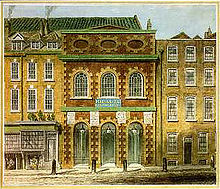
Francesco Bernardi, known as Senesino, was a celebrated Italian contralto castrato, particularly remembered today for his long collaboration with the composer George Frideric Handel. He was also involved in a public scandal with the soprano Anastasia Robinson in 1724 which was circulated widely by the satirist Jonathan Swift, and inspired a number of anonymously written obscene, misogynistic, and at times sexually subversive epistles written between 1724 and 1736 which have become a topic of study among scholars of Restoration literature.

Giulio Cesare in Egitto, commonly known as Giulio Cesare, is a dramma per musica in three acts composed by George Frideric Handel for the Royal Academy of Music in 1724. The libretto was written by Nicola Francesco Haym who used an earlier libretto by Giacomo Francesco Bussani, which had been set to music by Antonio Sartorio (1676). The opera was a success at its first performances, was frequently revived by Handel in his subsequent opera seasons and is now one of the most often performed Baroque operas.

Rodelinda, regina de' Longobardi is an opera seria in three acts composed for the first Royal Academy of Music by George Frideric Handel. The libretto is by Nicola Francesco Haym, based on an earlier libretto by Antonio Salvi. Rodelinda has long been regarded as one of Handel's greatest works.

Rhadamistus was a royal prince of the Pharnavazid dynasty of the Kingdom of Iberia who reigned over the Kingdom of Armenia from 51 to 53 and 54 to 55. He was considered a usurper and tyrant, who was overthrown in a rebellion supported by the Parthian Empire.

Flavio, re de' Longobardi is an opera seria in three acts by George Frideric Handel. The Italian-language libretto was by Nicola Francesco Haym, after Matteo Noris's Flavio Cuniberto. It was Handel's fourth full-length opera for the Royal Academy of Music. Handel had originally entitled the opera after the character of Emilia in the opera.
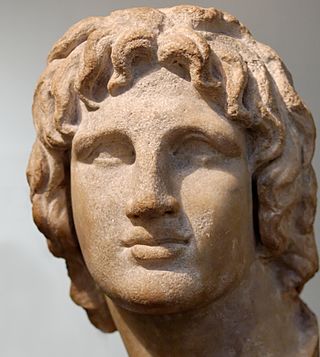
Alessandro, is an opera composed by George Frideric Handel in 1726 for the Royal Academy of Music. Paolo Rolli's libretto is based on the story of Ortensio Mauro's La superbia d'Alessandro. This was the first time the famous singers Faustina Bordoni and Francesca Cuzzoni appeared together in one of Handel's operas. The original cast also included Francesco Bernardi who was known as Senesino.

Scipione, also called Publio Cornelio Scipione, is an opera seria in three acts, with music composed by George Frideric Handel for the Royal Academy of Music in 1726. The librettist was Paolo Antonio Rolli. Handel composed Scipione whilst in the middle of writing Alessandro. It is based on the life of the Roman general Scipio Africanus. Its slow march is the regimental march of the Grenadier Guards and is known for being played at London Metropolitan Police passing out ceremonies.

Tolomeo, re d'Egitto is an opera seria in three acts by George Frideric Handel to an Italian text by Nicola Francesco Haym, adapted from Carlo Sigismondo Capece's Tolomeo et Alessandro. It was Handel's 13th and last opera for the Royal Academy of Music (1719) and was also the last of the operas he composed for the triumvirate of internationally renowned singers, the castrato Senesino and the sopranos Francesca Cuzzoni and Faustina Bordoni.

Orlando is an opera seria in three acts by George Frideric Handel written for the King's Theatre in London in 1733. The Italian libretto was adapted from Carlo Sigismondo Capece's L'Orlando after Ludovico Ariosto's Orlando Furioso, which was also the source of Handel's operas Alcina and Ariodante. More an artistic than a popular success at its first performances, Orlando is today recognised as a masterpiece.

Ottone, re di Germania is an opera by George Frideric Handel, to an Italian–language libretto adapted by Nicola Francesco Haym from the libretto by Stefano Benedetto Pallavicino for Antonio Lotti's opera Teofane. It was the first new opera written for the Royal Academy of Music (1719)'s fourth season and had its first performance on 12 January 1723 at the King's Theatre, Haymarket in London. Handel had assembled a cast of operatic superstars for this season and the opera became an enormous success.

Oreste is an opera by George Frideric Handel in three acts. The libretto was anonymously adapted from Giangualberto Barlocci’s L’Oreste, which was in turn adapted from Euripides' Iphigeneia in Tauris.
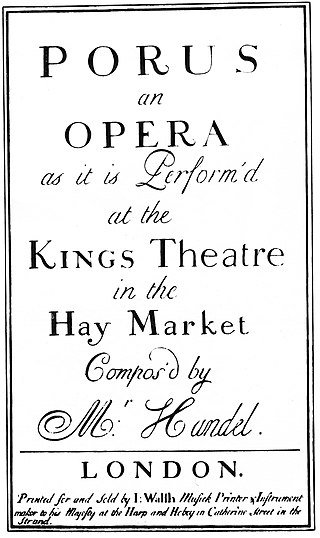
Poro, re dell'Indie is an opera seria in three acts by George Frideric Handel. The Italian-language libretto was adapted from Alessandro nell'Indie by Metastasio, and based on Alexander the Great's encounter with Porus in 326 BC. The libretto had already been set to music by Leonardo Vinci in 1729 and was used as the text for more than sixty operas throughout the 18th century.

Floridante is an opera seria in three acts by George Frideric Handel. The Italian-language libretto was by Paolo Antonio Rolli after Francesco Silvani's libretto for Marc'Antonio Ziani dramma per musica La costanza in trionfo of 1696.

Arianna in Creta is an opera seria in three acts by George Frideric Handel. The Italian-language libretto was adapted by Francis Colman from Pietro Pariati's Arianna e Teseo, a text previously set by Nicola Porpora in 1727 and Leonardo Leo in 1729.

Lotario is an opera seria in three acts by George Frideric Handel. The Italian-language libretto was adapted from Antonio Salvi's Adelaide.The opera was first given at the King's Theatre in London on 2 December 1729.

Anastasia Robinson, later known as Anastasia, Countess of Peterborough, was an English soprano, later contralto, of the Baroque era. As a performer, she is best remembered for her association with the composer George Frideric Handel, in whose operas she sang. She created roles in the world premieres of several of Handel's operas, including Zenobia in Radamisto (1720), Irene in Muzio Scevola (1721), Elmira in Floridante (1721), Matilda in Ottone (1723), Teodata in Flavio (1723), and Cornelia in Giulio Cesare (1724).

The Royal Academy of Music was a company founded in February 1719, during George Frideric Handel's residence at Cannons, by a group of aristocrats to secure themselves a constant supply of opera seria. It is not connected to the London conservatoire with the same name, which was founded in 1822.

Admeto, re di Tessaglia is a three-act opera written for the Royal Academy of Music with music composed by George Frideric Handel to an Italian-language libretto prepared by Nicola Francesco Haym. The story is partly based on Euripides' Alcestis. The opera's first performance was at the Haymarket Theatre in London on 31 January 1727. The original cast included Faustina Bordoni as Alcestis and Francesca Cuzzoni as Antigona, as Admeto was the second of the five operas that Handel composed to feature specifically these two prime donne of the day.
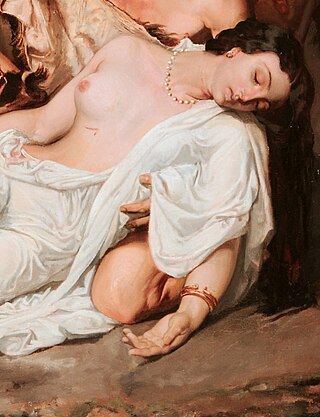
Zenobia of Armenia was a royal Iberian princess of the Pharnavazid dynasty who was a Queen of Armenia from 51 to 53 and 54 to 55 during the reign of her husband, King Rhadamistus.

Zenobia e Radamisto is an opera in 3 acts and nine scenes by composer Giovanni Legrenzi. The opera uses an Italian language libretto by Ippolito Bentivoglio (1611–1685). The third opera written by Legrenzi, the work premiered on 1 June 1665 at the Teatro Bonacossi in Ferrara in celebration of the marriage of Nicolò Santini and Maria Luisa Bonvisi. The opera was subsequently mounted in Brescia (1666), Verona (1667), and Macerata (1669).


